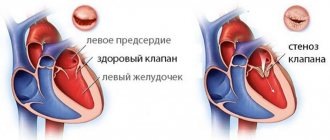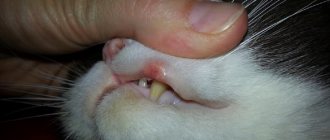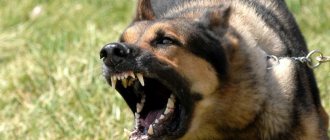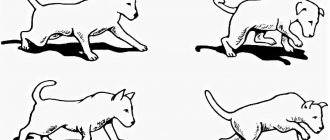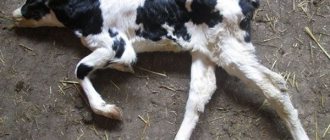Helminths in cats
Parasites cause enormous damage to the animal’s body, undermining its protective functions and injuring internal organs. The cat family is most often susceptible to attacks by two types of worms:
- nematode roundworms;
- tapeworms cestodes.
The risk of infection is high: helminth eggs are found in the soil and are resistant to environmental conditions.
Table 1. Description of cestodes and nematodes
| View | Description | Method of infection | Common diseases |
| They mainly live in the digestive system. They can also be encapsulated in other organs. Feeding on food bolus | Through food or skin, less often in utero | Toxocariasis, hookworm | |
| They live in the intestines, clinging to its walls and injuring tissues. Food source is blood. Most often found in adult worms | When ingesting larval vectors | Teniosis, diphyllobothriasis |
Consequences of helminthiasis
The prolonged presence of parasites leads to anemia and degeneration of internal organs. The clinical picture of other diseases against the background of helminth infection becomes more complicated.
Complications are caused by intoxication of the animal’s body, which is caused by the activity of worms. With mass infestations, pets suffer from intestinal obstruction. This pathology causes intestinal rupture, which can be fatal.
Table 2. Pathological processes during helminthic infestation
| Pathological process | Description |
| Metabolic disease | As a result of the vital activity of parasites, special toxins are released, which are allergens and poisons. The concentration of these elements in the body leads to disruptions in the metabolic process |
| Vitamin deficiency in the pet's body | By feeding on the blood or food bolus of the host, parasites steal nutrients. As a result, the animal does not receive enough vitamins and beneficial elements in the food. |
| Intestinal dysbiosis | Products resulting from the activity of worms in the body provoke the development of dysbacteriosis. To avoid being digested in the intestines, parasites secrete antienzymes for protective purposes. These substances lead to an imbalance between beneficial and pathogenic microflora |
| Decreased immunity | Helminths destroy white blood cells designed to fight infections |
| Impaired blood supply | Some varieties of worms parasitize on the walls of organs, attaching to them using special suction cups. In addition to feeding on blood, they cause tissue death. Becoming larger in size, helminths put pressure on neighboring tissues, which can impair blood supply |
Causes and routes of infection
Parasites no larger than 2 cm in size are armed with three teeth, with which they bite into the intestinal mucosa and destroy the walls of capillaries. Parasites secrete a secretion that prevents blood clotting and interferes with the absorption of nutrients, especially vitamins.
The eggs of sexually mature nematodes are excreted in feces and mature in the external environment for about a week. From them emerge invasive larvae capable of infection. The animal swallows them, digging with its nose in the grass or soil. The second method of infection is the penetration of larvae through the skin. Sometimes juvenile hookworms attack small rodents and birds, and if a carnivore swallows the prey, it will also become infected. The larvae survive in a humid environment for up to two weeks.
The larva that penetrates through the skin reaches the lung, feeds, molts, causes a cough, enters the mouth, and from there into the intestines. When swallowed, the larva makes its way through the mucous membrane into the blood, from there into the lungs, or is immediately swallowed. Migrating juvenile hookworms settle in other organs, cause a mild inflammatory reaction and die.
The larvae cross the placental barrier and infect the young in utero. Another route of infection is through colostrum.
Hookworm in cats
Hookworms are typical parasites of cats and dogs.
Hookworms is the English designation for this type of worm. The term literally translates as hook worm, which accurately reflects the appearance of the parasite. In the area of the head it has a special hook with which it is fixed to the intestinal walls.
Characteristics of the helminth:
- light pink color;
- body thickness up to 0.6 mm;
- male length up to 1 cm;
- female length up to 2 cm;
- the number of eggs per day is up to several thousand;
- puberty period from 2 to 3 weeks;
- The shelf life of eggs in humid conditions is up to 2 years;
- food preferences blood and small intestinal tissue.
There is no intermediate host in the worm development chain.
The mechanism by which the helminth enters the animal’s body may be different. The worm enters through the skin or food, less often in utero. Unsanitary conditions and crowded housing are the main culprits for parasite infestations. In cat shelters, for example, the infection rate can reach 100%.
Life cycle
Depending on the conditions of penetration into the body, the life cycle of hookworms may differ.
The larvae enter the intestines along with contaminated water or food.
Given the excellent swimming abilities of the larvae, rainy weather poses a particular danger for pets. Hiding in raindrops, on the grass or in puddles, they wait for the opportunity to attack a passing animal.
In rare cases, the larvae migrate through body tissue, becoming encapsulated in organs or muscles.
Compared to dogs, cats are considered carriers of a small number of hookworm varieties. In addition, cat parasites do not cause such dangerous consequences for the pet’s life. For example, babies of infected bitches become infected with helminths while in the womb. Such situations practically never occur among cats. However, worms can be passed from mother to baby through breastfeeding.
Symptoms of hookworm
The disease caused by the presence of hookworms in the body is called hookworm. At an early stage, the disease practically does not manifest itself. By attaching to the walls of the small intestine, parasites feed on its tissues. However, this process does not cause much discomfort to pets.
The situation becomes more complicated when the worms begin to feed on blood. To obtain more red liquid, they create small wounds in the organ and inject a substance into them that prevents blood clotting.
The action of the anticoagulant leads to disruption of the animal's blood supply. Damage left by parasites bleeds for a long time and causes pain. Kittens especially suffer from blood drainage. Children quickly develop anemia.
Manifestations of hookworm:
- anemia;
- lack of appetite;
- apathy;
- bowel disorders;
- hair loss;
- itching in the anal area;
- mucous discharge from the eyes;
- the presence of undigested blood in the stool;
- rapid weight loss;
- inflammation of the paw pads;
- pale gums;
- tarry color of feces.
Dull hair is also a warning sign.
Diagnosis of the disease
Diagnosis of pathology is carried out by microscopic examination of stool.
The number of eggs found in stool does not always indicate the number of eggs present in the body. When there is excessive accumulation, the parasites begin to suppress each other. This leads to situations in which, during an exacerbation of the pathology, fewer eggs are found in the feces than during a mild form of the pathology.
In small kittens, the disease is not always determined by the presence of eggs in the feces. Even if they are absent from the stool, dangerous parasites may already live in the baby’s body. In this situation, diagnosis is made based on indirect symptoms.
Video Hookworm: the causative agent of hookworm
Hookworm symptoms in humans
Hookworms manifest themselves differently in humans. With a small invasion, severe symptoms may be absent: it is not uncommon for the first signs to appear only after several months or even years. Since the parasite larvae are microscopic in size, their penetration through the skin occurs painlessly, leaving no traces on the dermis.
The first symptoms of hookworm can make themselves felt during the migration of the larvae into the lungs. A cough develops, fever, general weakness and malaise may appear. After the parasite enters the gastrointestinal tract, you can observe:
- Pain in the abdominal area;
- Nausea and vomiting;
- Decreased appetite.
A characteristic symptom of hookworms is the development of anemia. The fact is that the adult parasite feeds on blood, biting through the walls of capillaries in the intestines. With severe invasion, blood loss can be significant.
Treatment of hookworm
Despite the danger of the pathology, it is easily treatable. Especially when parasites are detected at an early stage of their development.
Basic rules of treatment:
- A sick pet should be isolated from healthy animals while fighting the disease.
- Both medications and traditional recipes are used.
- New generation anthelmintic drugs contain either one active ingredient, the action of which is aimed at combating a specific helminth, or several. Since a pet is often infected with several parasites at the same time, it is advisable to choose a multifunctional product.
- In parallel with therapy, the animal should be switched to therapeutic food. This measure will help cope with anemia.
- Veterinarians recommend using medications containing iron, folic acid and B vitamins. Taking these medications helps restore red blood cells and stimulates the hematopoietic organs.
- 1 month after the end of treatment, you need to do a repeat stool examination. If helminths are found in the feces, undergo a second course of therapy using a different anthelmintic drug.
If the disease progresses to an acute stage, a blood transfusion may be required.
Folk remedies
Home medicine recipes are not as effective as pharmaceutical products. However, they can be used as a concomitant treatment.
- Sugar cubes. Give it to your pet several times a day, mixing it with food or pouring a sugar solution into the esophagus using a syringe.
- A decoction of chamomile or fennel. Brew 25 mg of the collection in 250 ml of boiled water and give it to drink instead of drinking water.
- Onion. Cut the vegetable into 4 parts, pour 1 glass of warm water and give in the morning on an empty stomach.
- Infusion of common tansy. 1 tbsp. pour 250 ml of boiling water over the flowers and leave. Give 3 times a day 30 minutes before meals.
- Alcohol tincture of wormwood. This pharmaceutical product is given to the cat 10 drops 2 times a day 1 hour before meals.
Duration of treatment until complete recovery.
Medical nutrition
To support your pet's body while fighting parasites, you should put the animal on a high-calorie diet. Parasites absorb the nutrients your pet needs, so it is necessary to make up for their absence.
Basic dietary canons:
- Eliminate raw foods from the menu, especially fish.
- Meat products and eggs should make up up to 65% of the diet.
- It is useful to add 1 tbsp to food. olive oils. This measure will help increase the fatty component of food.
- Despite the ban on raw foods, liver is an exception. It will help increase your iron levels. Recommended dose 1 time per day for 2 weeks.
- Taking vitamin supplements. Kittys Mix, Phytomins, Hematocat will perfectly strengthen your pets' immunity.
- Taking enzyme medications. These medications will help you absorb the maximum nutrients from food.
When choosing food supplements and body support products, you should take into account the animal’s intolerance to the components in their composition.
Hookworm infection in animals (cats, dogs)
Quite often, cats and dogs become infected with nematodes. Infection of animals can occur through the skin, placenta, mother's milk and the fecal-oral route.
If a cat eats food or drinks water with hookworm larvae, they easily penetrate the small intestine and develop into adults. The process usually takes 21 days. Just like in humans, parasites in animals feed on blood. Helminth eggs are released into the environment with feces. The disease is dangerous due to the development of anemia and general toxic damage to the body.
The following symptoms will help determine hookworm infection in cats:
- decreased appetite;
- depressed state;
- dull coat;
- blood in stool;
- inflammation of the paw pads.
After diagnosing the disease, the animal must be treated. Usually it is limited to a single dose of drugs such as Pyrantel, Praziquantel or Mebenvet granulate. The dosage of the medication depends on the weight of the cat.
Additionally, the animal is prescribed supplements such as Ferrum Lek, injections of folic acid and B vitamins. With the help of these medications, the functioning of the hematopoietic system and the number of red blood cells in the body are normalized.
Hookworm infection in dogs also causes severe intestinal damage. Most often, invasion occurs through the fecal-oral route. Less commonly, parasite larvae enter the animal through breaks in the skin, causing urticaria and anemia.
As a result, the dog loses interest in its surroundings, becomes lethargic, refuses food and dies without timely help. The symptoms listed above and laboratory analysis of stool help to diagnose the pathology.
Treatment of hookworm in dogs is carried out with the drugs Tenium and Naftamon. They are offered to the animal along with food. Additionally, veterinarians recommend how to treat anemia in a pet using iron-containing medications.
Prevention of hookworm
To avoid infection of the animal with parasites, deworming should be carried out periodically. Recommended timing:
- preventive once every 3 months;
- 10 days before scheduled vaccination;
- 3 weeks before birth;
- after birth 2 weeks.
The use of antiparasitic agents for kittens is allowed from three weeks of age.
For deworming, the following means are used:
- Piperazine at the rate of 0.2 g/1 kg of weight for 3 days.
- Naftamon, 0.3 g/1 kg for 3 days.
- Mebenvet, 0.6 g/1 kg once.
Mixing drugs with minced meat is allowed.
In addition to these preventive measures, periodic disinfection of pet care items and the area where it is kept is necessary. If the animal lives in a country house, the area adjacent to it should be treated with a borax-based solution or salt.
Life cycle of hookworm
In the body, hookworms in humans undergo a maturation cycle until they reach a sexually mature individual, that is, they are the definitive host for the parasite. The main habitat of the helminth is the duodenum, from where the eggs are released along with feces into the environment.
Hookworm development cycle:
- After entering the soil, the larvae transform into a rhabdoid form and then become filariform larvae. This form is capable of infection. For this transformation of eggs into larvae, certain conditions are required: temperature of at least +27°C, high humidity, aerated soil.
- For one and a half years, the filariform larva retains the ability to invade (penetrate) the human body in order to reach sexual maturity.
- The percutaneous method of infection is through the skin. Having penetrated into the deep layers of the dermis, the larva penetrates the blood, then with its current enters the respiratory system, into the mouth and from there enters the intestines.
- The oral route of infection occurs by ingesting larvae. They immediately arrive at their habitat and begin to penetrate the intestinal mucosa.
- After 1.5-3 months of living in the digestive tract, female hookworms become sexually mature and lay eggs.
- After hookworm eggs are released along with feces, a new cycle of helminth development begins.
The productivity of one female hookworm is 6-55 thousand eggs per day. The eggs are not visible to the naked eye; they have an oval shape, a thin shell, and are visible only under a microscope.
Ways of infection by parasites:
- When walking barefoot;
- When drinking raw water and poorly washed vegetables that enter the body with soil particles;
- When working in a mine;
- When children come into contact with soil contaminated with sand on the playground.
How can a cat become infected with worms?
A pet can become infected with parasites in several ways. Helminth eggs are found in raw fish and meat. Unfiltered water can also become a source of infestation.
The owner can bring parasite larvae on shoes or clothing. If a cat walks outside, the range of possibilities for infection expands significantly. Grass in flower beds, water in puddles and feces of other animals are dangerous.
The damage that worms cause to a cat's body
While there are few parasites, the animal may not notice their presence in its body. But a large number of worms can significantly deplete the body. And a constant increase in the number of helminths will sooner or later lead to the death of the cat.
Worms living in the body of a pet harm it in different ways:
- worms feed on the blood, tissues and lymph of their host;
- helminths produce substances that lead to intoxication of the cat’s body;
- when the parasite dies, its decomposition products also poison your pet’s body;
- The suckers with which worms attach to organs can damage the mucous membranes of internal organs. This may lead to internal bleeding.
Hookworms in humans
The most common type of infection in humans is Ancylostoma duodenale. Necator americanus also often infects people, but at least it is called the “new world hookworm” - it belongs to a different genus from the same family as hookworms.
Pathology and clinical symptoms
Many people infected with hookworms may not experience any symptoms. In general, the development of the disease depends on the type of parasite, the intensity of the infection, and the general condition of the patient. The sequential development of the parasite causes three stages of the disease:
- cutaneous phase, when invading larvae can cause dermatitis;
- the pulmonary phase, when migrating larvae can cause pneumonia;
- intestinal phase, in which adult worms can cause anemia.
Infectious larvae penetrate the skin and invade blood vessels in the dermis, causing moderate to severe secondary infections leading to allergic dermatitis with papular, and sometimes vesicular, patchy rash and pruritus. Larvae from hookworms that infect animals (especially A. caninum and A. braziliense) can also penetrate human skin, but are not able to complete their development there. Instead, they migrate aimlessly through the skin over a period of days or weeks, leaving red, itchy sores that can cause secondary infections. The resulting condition is known as creeping rash or Larva migrans skin syndrome and is characterized by local dermatitis, pruritus and inflammation (edema, erythema).
The next stage of the disease occurs during pulmonary migration of the larvae, when they are in the air space of the alveoli, causing focal hemorrhages and allergic pneumonia (the severity of the disease depends on the number of larvae).
Once the larvae reach the small intestine, they complete their final molt, attach to the mucous membrane, and begin feeding on blood (hookworms can suck about 0.26 ml of blood per day). Loss of blood in a person can lead to severe iron deficiency anemia and hypoproteinemia.
Patients with severe infections experience severe protein deficiency, dry skin and hair, swelling, delayed puberty in children, mental retardation, and heart failure.
Diagnostics
Diagnosis of hookworm infection is based on the study of clinical symptoms, as well as confirmation of the diagnosis by detecting parasite eggs in fecal samples using microscopy.
Prevention of worms in cats
Since there are many ways and sources of helminth infection in cats, it is necessary to follow some rules that will help prevent invasion.
Preventive measures against worms in cats:
- Never give your cat raw fish and meat; they must be thoroughly boiled;
- frequent change of litter and contents of the cat litter box, maintaining their cleanliness, periodic disinfection;
- periodically carry out preventive deworming of the cat: at least once every 3 months (this is especially true for animals that often walk outdoors in the yard, park and other walking areas), 2 weeks before the intended mating and 10 days before giving birth;
- thorough disinfection of places where animals visit after preventive and therapeutic deworming;
- treating cats with medications against fleas, which can also be sources of infestation.
- Hookworms in cats - symptoms, signs and general treatments
- Treatment of cats for worms - signs and types of parasites
- Cat helminths - what they exist, signs and treatment methods
Hookworm in cats: how to treat with drugs
As for medications, the veterinarian usually prescribes universal drugs for the animal, designed to destroy cestodes and nematodes. Almost any drug of similar purpose can be suitable in this case.
Worms in cats (hookworms are no exception in this regard) are most often treated with products made on the basis of:
- pyrantela;
- praziquantel;
- milbemycin.
In most cases, drugs such as Fenbendazole and Mebenvet are used to treat cats. The course of treatment with the first type is 5 days. The animal is given a tablet once a day. The cat is also treated with Mebenvet for 5 days. But they give her two tablets a day.
Are roundworms transmitted from cats to humans?
Helminthiasis is spread by hookworm eggs, which end up in the external environment with human feces. Under optimal conditions, it will take only a week for the larva to emerge. Then the future nematodes climb up the plants, above ground level. After this, they penetrate the skin of a person’s legs and feet upon contact.
It is also known that hookworm is able to cross the placenta and infect the fetus in the body of a pregnant woman in utero.
Many owners are concerned that worms from cats can be transmitted to humans. Let's not lie, owners and pets have quite a lot of common parasites and an invasion can really happen. However, the owner must understand that he is more likely to infect the pet than vice versa.
People are much more likely to come into contact with surfaces infested with worm eggs. If you have the habit of eating outside, often visit public places and use public transport, your palms and outer clothing are a source of infection for your pet.
It is worth accepting as a fact that you cannot protect yourself from worms, so the only way to avoid unpleasant consequences is regular prevention.
Life cycle of hookworm
Hookworm larvae hatch from eggs in the ground; They enter the body of the final host through damaged skin when working in the garden, walking barefoot, and so on. The larvae bite through the skin and enter the bloodstream, after which they are spread throughout the body along with the liquid. For some time, the larvae linger in the heart and lungs, causing a cough, then again they drill capillaries in the alveoli, enter the bronchi, the pharynx and are swallowed along with saliva.
After 4-6 weeks in the duodenum, the larvae develop into adults. A female hookworm is capable of producing up to 10,000 eggs per day, which, together with feces, are excreted from the body and then enter the soil and the cycle repeats.
The hookworm parasite can live in the human body for up to 8 years. Currently, according to medical data, this helminth affects up to 25% of the world's population. The widespread prevalence of the worm is partly explained by the fact that the symptoms of hookworms are not pronounced or mild.
Treatment and prevention of hookworm disease in humans
In addition to animals, people are also susceptible to hookworm infection. Before getting a cat, you should familiarize yourself with the following facts:
- Parasites are especially dangerous for children who have close contact with pets.
- Every year, every second person on earth becomes infected with one of the 3 main types of parasites.
- Depending on the number of helminths present in the body, a person can lose up to 0.5 liters of blood per day.
- Hookworm larvae pass from animals to humans.
- The most accurate test for the presence of helminths is enzyme immunoassay. This test is effective in 90% of cases. Diagnosing helminthiasis by examining feces does not always give a true result.
If parasites are found in a pet, their owners should immediately undergo deworming.
Traditional therapy and folk methods
Drugs for the treatment of hookworm are prescribed by the attending physician, taking into account the individual characteristics of the patient, the severity of the disease and existing complications. The most common medications to combat pathology are as follows:
- Mebendazole;
- Dekaris;
- Albendazole;
- Pirantel.
Among the folk recipes that help with illness are onion tincture, a decoction of unripe walnuts and an infusion of birch buds.
Diagnosis and treatment
The diagnosis is made on the basis of clinical symptoms, the epizootic situation in the nursery, and the detection of parasite eggs in feces. Coprological examination is effective only in the chronic form, because the young die before the hookworms reach sexual maturity.
Treatment consists of parenteral administration of complex preparations containing iron, microelements and vitamins - Hemobalance or analogues. The pet is provided with complete ready-made food of at least premium class. Depending on the condition of the animal, the doctor prescribes antimicrobial drugs and anthelmintics.
After recovery, the beneficial intestinal microflora is restored with the help of probiotics and prebiotics.
Forecast
Usually, after treatment, cats recover quickly. Almost immediately after taking the pill that completes the course, the parasites leave the body or die inside, and are subsequently eliminated naturally.
Older cats may heal a little more slowly. In exceptional cases, the body cannot cope with helminths and, unfortunately, does not live to see them completely eliminated from the body. But this applies to very sick or old individuals.
If the animal is kept in good conditions and its diet includes large amounts of protein and iron, then the prognosis is quite favorable. The body will receive the most benefit at this time by consuming iron-rich beef, pork, poultry and fish. Since the body requires a significant amount of protein to recover, the cat needs to be given it through products such as eggs, sour cream, and milk.
After deworming and measures to strengthen the body, the cat fully recovers and the likelihood of relapse is eliminated.
Hookworms in dogs, cats and other animals
Most often, cats and dogs are infected with nematodes of the species Ancylostoma caninum and Ancylostoma braziliense, respectively.
Animals can become infected with hookworms in one of four ways:
- orally;
- through the skin;
- through the mother's placenta;
- through mother's milk.
➊ Inside the small intestine of a dog or cat, adult hookworms release eggs.
➋ Eggs are passed in feces approximately 10-21 days after infection. ➌ Feces contaminate the soil, where larvae develop from eggs after about a week. ➍ When walking or playing, where dogs (less often cats) frequent, the larvae can infect people by penetrating the skin. But this will only cause temporary dermatitis, since canine and feline hookworms cannot live in the human body. ➎ Contaminated soil on objects or paws puts animals at risk of infection through the mouth. ➏ The larvae may remain dormant in the dog's skeletal muscles. ➐ The larvae can penetrate the animal's skin. ➑ A puppy or kitten can become infected through milk, when larvae migrate to their mother’s mammary glands. Female hookworms produce thousands of microscopic eggs that are transmitted in the feces of infected dogs and cats, with which they contaminate the environment. The larvae are released from the eggs and can remain in the soil for several weeks or months. An animal can become infected when it inadvertently ingests hookworm larvae by licking its feet, sniffing feces or contaminated soil. The larvae can also burrow into the skin if the animal is walking or lying on the ground. After entering the host, the larvae migrate to the intestine, where they mature and complete their life cycle. Part of the life cycle of nematodes involves migration through muscle tissue, where they can remain dormant.
Precautionary measures
There is a huge variety of bacteria, worms and parasites in the world.
It is necessary to be careful and diagnose your pet as often as possible.
- If the kitten was adopted from a shelter, accordingly, for safety reasons, not only it, but also the owner should be treated with anti-worm medications, or vaccinated at a veterinary clinic.
- It is required to carry out general cleaning of the area weekly, as well as constantly change the tray filler and clean the tray itself.
- If your cat constantly walks in the yard, then it is necessary to regularly spray the yard with any means of parasite control.
- It is necessary to wash your pet's paws after walking and also inspect them.
- You should not give your cat the opportunity to walk near garbage accumulations; as you know, most parasites live there. When a cat is hungry, it can eat waste and, as a result, become infected with hookworm.
These simple recommendations will help the owner save nerves and patience, and also save his beloved pet from problems.



